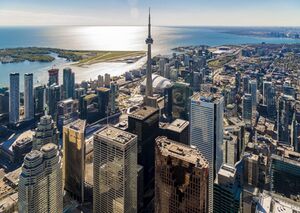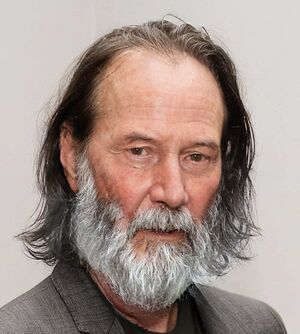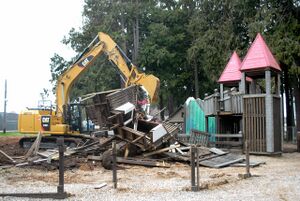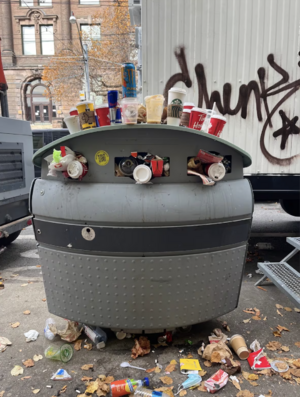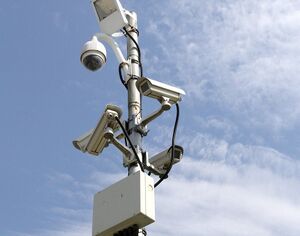Group 5: Difference between revisions
Kelly Chen (talk | contribs) No edit summary |
Kelly Chen (talk | contribs) |
||
| Line 28: | Line 28: | ||
Surveillance is now a fundamental part of daily life, ensuring everyone’s actions are tracked and analyzed. Cameras line every block, and public spaces are patrolled by security guards. Malls, restaurants, and plazas have AI systems that scan every face and action in real time. The slightest misstep, wrong word, or poor decision is recorded and can result in the loss of privileges, jobs, or even homes. Those who reject the surveillance system are considered outcasts and are forced to live off the grid in remote rural areas away from the public eye. | Surveillance is now a fundamental part of daily life, ensuring everyone’s actions are tracked and analyzed. Cameras line every block, and public spaces are patrolled by security guards. Malls, restaurants, and plazas have AI systems that scan every face and action in real time. The slightest misstep, wrong word, or poor decision is recorded and can result in the loss of privileges, jobs, or even homes. Those who reject the surveillance system are considered outcasts and are forced to live off the grid in remote rural areas away from the public eye. | ||
[[File:Screenshot 2024-12-01 at 10.51.07 pm.png|thumb|A public city garbage bin left unattended to]] | |||
Toronto’s once diverse and welcoming neighbourhoods are now segregated by class and status. The wealthy districts, Smart Cities or Exclusive Zones, look like gated fortresses that are equipped with cutting-edge technology and artificial intelligence. Entry into these zones is regulated with biometric identification (facial and voice recognition) verifying a high social credit score. Smart Cities are constantly monitored, with residents’ every move being tracked by AI and cameras. The more pristine and well-maintained the neighbourhood is, the higher the social status of the residents. Thus, these areas are very clean as no one dares to litter or pollute public spaces. Only those with perfect reputations have access to large and luxurious homes, which are designed to showcase the flawlessness of their homeowners. The backyards lack play structures for children to explore and are instead rigid with cement and dining spaces to host social gatherings with other Paragons. The Paragons living here enjoy exclusive privileges like access to private schools, top medical facilities, and entertainment. | Toronto’s once diverse and welcoming neighbourhoods are now segregated by class and status. The wealthy districts, Smart Cities or Exclusive Zones, look like gated fortresses that are equipped with cutting-edge technology and artificial intelligence. Entry into these zones is regulated with biometric identification (facial and voice recognition) verifying a high social credit score. Smart Cities are constantly monitored, with residents’ every move being tracked by AI and cameras. The more pristine and well-maintained the neighbourhood is, the higher the social status of the residents. Thus, these areas are very clean as no one dares to litter or pollute public spaces. Only those with perfect reputations have access to large and luxurious homes, which are designed to showcase the flawlessness of their homeowners. The backyards lack play structures for children to explore and are instead rigid with cement and dining spaces to host social gatherings with other Paragons. The Paragons living here enjoy exclusive privileges like access to private schools, top medical facilities, and entertainment. | ||
At the opposite end of the spectrum are the forgotten neighbourhoods that are home to those with lower social credit scores. These isolated areas are underdeveloped with less frequent garbage collection and landscape maintenance and fewer amenities. Access to jobs and public services is limited to these Errant and Edgewalker residents. These neighbourhoods are often seen as temporary homes, with many people anxiously wanting to escape and move up to higher-status zones but are ultimately trapped here. The streets are quieter, not from peace, but from the absence of hope. | At the opposite end of the spectrum are the forgotten neighbourhoods that are home to those with lower social credit scores. These isolated areas are underdeveloped with less frequent garbage collection and landscape maintenance and fewer amenities. Access to jobs and public services is limited to these Errant and Edgewalker residents. These neighbourhoods are often seen as temporary homes, with many people anxiously wanting to escape and move up to higher-status zones but are ultimately trapped here. The streets are quieter, not from peace, but from the absence of hope. | ||
Revision as of 19:53, 1 December 2024
Background
On January 5th, 2055, Keanu Reeves was walking his dog along Baldwin Street in Toronto. While talking on the phone, his dog had a bathroom break on the side of the sidewalk. Reeves, still on the phone, had not had a chance to clean up after the dog and a lady walking by slipped on the excrement, fell, and broke her tailbone. Reeves, having headphones in his ears, did not know the lady fell and was not quick to help her. As this was occurring, a fan across the street was videotaping the whole occurrence and stopped filming right before Keanu profusely apologized and helped the lady. The video went viral on social media with users saying things such as:
“ I can’t believe that of all people, Keanu Reeves would do something like this. That poor lady did not deserve that treatment at all #keanureevesisoverparty”
“I thought Keanu Reeves was one of the good ones. Who can you even trust anymore?! #cancelkeanureeves”
Since then, the general public refused to forgive Reeves for what he had done and even after he tried to tell his side of the story, people had seen enough. Reeves was exiled from Hollywood and people have rarely seen him since. This became known as the Keanu-apocalypse.
This was the catalyst for a shift in society. North Americans felt that they did not know who to trust. If one of the most beloved public figures could do something like this, how could people trust anyone? The government had to step in during this time of uncertainty.
Eleanor Halewood, the MPP for the University-Rosedale area, where the incident occurred, began gathering ideas for how to combat this sudden distrust. Halewood proposed the idea of a separation society called “unforgivable.” On January 25th, 2055, Halewood spoke to reporters about her recommendation, marking it the first time the idea was tabled in the public space. Halewood initiated that any legal mistakes made be categorized as major offences and would classify people as “unforgivable.” Unforgivables would lose access to privileges within the city. This allowed for society to gain back their trust of each other because there were categorization systems that enabled people to know that who they were with were people who did not make mistakes.
Location and Geography
Ever since the catastrophic shift in society triggered by Keanu Reeve’s downfall and exile in 2055, Toronto has transformed into a city obsessed with perfection, surveillance, and unforgivable violations. What was once a vibrant metropolis filled with life and energy is now a city where conformity and strict control dominate daily lives. The geography of Toronto has become a place where every movement, from the second you step outside your door to your interactions with one another on the street, is monitored and affects your social score.
The days of open parks and playful spaces are long gone. Most of Toronto’s beloved green areas and recreational spaces have been replaced by corporate towers and exclusive private social clubs that only people with perfect social credit scores can access. The few remaining parks from 20 years ago have been remade into pristine parks that are heavily monitored and patrolled by security to keep out any “unforgiveables”. These spaces have now become symbols of status and privilege, mainly for adults, rather than for relaxing or interacting with friends and neighbours. They are reserved for children of the elite Paragon class, while Edgewalker children would not even dare to be caught near these parks. However, even Paragon children spend very little time in these spaces compared to before the “Keanu-apocalypse”, as their childhoods are now consumed by the pressure to be perfect. The obsession with adhering to beauty standards and academic achievement leaves little room for playtime or creativity. Children are taught from an early age to refine their skills or perfect their appearance rather than explore nature and the outdoors. Most youth and teens spend their free time in study pods and libraries or in skill/trade environments. As well, there is anxiety about children playing outside as parents fear that they can get hurt or accidentally push another child in the playground, ruining their reputation.
The city’s streets have been redesigned with wider roads for self-driving cars, known as RoboRides, which dominate the roads and push pedestrians into more narrower sidewalks. These high-status cars eliminate the potential for citizens to make a mistake when changing lanes or speeding. RoboRides have reduced traffic jams and accidents, providing greater convenience and efficiency for Paragons to seamlessly move through the city while maintaining their perfect public image. Errants and those with lower social standings do not have access to RoboRides and have to rely on public transportation or human-driven cars, which increase the likelihood of error. Few buses pass through the city at limited times of the day, often being overcrowded and significantly less efficient.
Surveillance is now a fundamental part of daily life, ensuring everyone’s actions are tracked and analyzed. Cameras line every block, and public spaces are patrolled by security guards. Malls, restaurants, and plazas have AI systems that scan every face and action in real time. The slightest misstep, wrong word, or poor decision is recorded and can result in the loss of privileges, jobs, or even homes. Those who reject the surveillance system are considered outcasts and are forced to live off the grid in remote rural areas away from the public eye.
Toronto’s once diverse and welcoming neighbourhoods are now segregated by class and status. The wealthy districts, Smart Cities or Exclusive Zones, look like gated fortresses that are equipped with cutting-edge technology and artificial intelligence. Entry into these zones is regulated with biometric identification (facial and voice recognition) verifying a high social credit score. Smart Cities are constantly monitored, with residents’ every move being tracked by AI and cameras. The more pristine and well-maintained the neighbourhood is, the higher the social status of the residents. Thus, these areas are very clean as no one dares to litter or pollute public spaces. Only those with perfect reputations have access to large and luxurious homes, which are designed to showcase the flawlessness of their homeowners. The backyards lack play structures for children to explore and are instead rigid with cement and dining spaces to host social gatherings with other Paragons. The Paragons living here enjoy exclusive privileges like access to private schools, top medical facilities, and entertainment.
At the opposite end of the spectrum are the forgotten neighbourhoods that are home to those with lower social credit scores. These isolated areas are underdeveloped with less frequent garbage collection and landscape maintenance and fewer amenities. Access to jobs and public services is limited to these Errant and Edgewalker residents. These neighbourhoods are often seen as temporary homes, with many people anxiously wanting to escape and move up to higher-status zones but are ultimately trapped here. The streets are quieter, not from peace, but from the absence of hope.
Since the 2055 shift, the overall atmosphere of Toronto has changed. There is a profound tension between the glittering perfection of the upper classes and the struggles of those who make mistakes and are demoted to the bottom of the social ladder. The geography of the city is not just a map of social divisions. The mood on the streets is hushed and anxious, with fear of judgement and making mistakes. Social media and constant surveillance have made people afraid to express their own opinions and speak freely. Although crime has decreased and the streets are cleaner, the cost of maintaining perfection has taken a toll on the mental well-being of the citizens.
Culture
By July 1st, 2055, the unforgivable society was fully implemented. This included rules that enforced that any broken laws would be counted as a strike. The exception to this rule was that any type of murder was to be deemed unforgivable. When citizens accumulated 3 strikes, they would be considered Unforgivable and no longer be able to have access to certain locations, events, and facilities. This resulted in many citizens who were deemed Unforgivable to leave the city and go off grid.
The government imposed this societal system through Digital Social Credit Systems also known as Motoriety. Motoriety is a technological surveillance system that tracks behaviour and stores information that is examined before citizens are able to access resources, services, or privileges. All citizens are screened before entering new places, and other citizens are able to check status through the Motoriety facial recognition app. This ensured that making mistakes was tethered to your identity.
Citizens with no strikes are called Paragons. Although 3 strikes often means exile, citizens who have 1 strike on record are called Errants , and people who have 2 strikes are called Edgewalkers. Having these labels contribute to your reputation and the way you are treated in society.
In most situations, Paragons will not interact with Edgewalkers because they do not want to ruin their own reputation by being seen with them, and they are afraid that the Edgewalkers will be a bad influence. Often, Edgewalkers are solitary people who keep to their own property. Most malls and restaurants will not let them in and Edgewalkers must go to a special grocery store that has higher surveillance to get food. If Edgewalkers have friends, it often consists of fellow Edgewalkers or Errants. However, even Errants are afraid to be associated with Edgewalkers for fear of getting a 2nd strike. Errants are still allowed into malls, restaurants, and facilities but they have more restrictions. Errants must order and pay simultaneously at restaurants. Errants must park at the back of parking lots in case they try to steal. Errants must be accompanied by a Paragon to access gyms. Paragons are often fine to interact with Errants but much prefer to interact with other Paragons.
The overall lifestyle is considered a perfectionist culture. 80% of citizens in the Greater Toronto Area are labelled Paragons. Most Paragons work hard to keep their Paragon status. In doing so, Paragons fear making mistakes, even so far as to misspell a word is anxiety inducing. If Paragons are leaving their house, they will spend 2 hours preparing their appearance to look perfect. Appearance is an indicator of reputation. Looking tidy and sleek coincides with a tidy and sleek record. This is due to the access to better clothing shops and products available. Paragons will go to driving simulations before testing for their driver’s license to ensure that they are prepared for all situations and can practice their reaction time. All citizens live in fear of doing unforgivable actions.
Paragons stick to their same group of people. Often fearing a disruption to their perfect system, Paragons do not enjoy change and do not enjoy bringing new people into their social group. As such, school friends frequently become lifelong friends. This has created a very quiet and lonely culture that places great value on individual satisfaction. Judgment is at an all time high in the city. All citizens are always on the lookout for people breaking the rules. Tattletales are no longer seen as an annoyance but are encouraged and celebrated.
The city is still heavily diverse although the amount of Errants, Edgewalkers, and Unforgivables that are racialized vastly outweigh white people. The extra surveillance on Black people did not stop when the new system was installed. Black communities have extra surveillance cameras and security patrolling because they are seen as more at risk for mistakes. Education rates in the city are at an all time high. Emphasis on studying and doing well at school has never been more important. Students expect to get over 80% on all assessments. Students work extremely hard to achieve these goals and studying culture has become central to teenagers’ lives. Going to the mall and the movies were substituted by Kahoot nights and exam practice dates. University and college are a requirement so that students are able to perfect their skills and use their perfect skills in society.
Government
At a first glance, the government of Toronto presents a perfectly orchestrated society, where efficiency and order govern every aspect of life. With a highly structured political system, Toronto thrives in a state of relative peace and perfection. Surveillance is omnipresent but discreet; cameras and sensors monitor every public space, while digital systems track citizen’s behaviour, ensuring conformity to social expectations. Public officials, especially at the municipal and provincial levels, actively enforce the belief that perfectionism is achievable and necessary. Policies that encourage optimal performance in every sector, from education to healthcare to transportation, are widely embraced. These policies have brought benefits to the city, such as cleaner streets, lower crime rates, and fewer incidents of public disorder. The rise of the “perfect” citizen, one who follows the rules and avoids public embarrassment, is known as the ultimate goal of governance.
However, the perfection that the government promotes comes with a price. The strict implementation of a social credit system, based on a person’s behaviour and interactions, creates a city where privacy and personal freedom are sacrificed in the name of order. Every action is tracked, and any minor deviation from the norm can result in severe consequences. This surveillance state has led to a deepening sense of distrust and paranoia among citizens, as individuals become hyper-aware of their every word, gesture, and action. Mistakes, no matter how insignificant, are viewed as unforgivable and punishable, further embedding fear and anxiety in daily life. While the government claims that this system ensures fairness, its rigidity stifles creativity, individuality, and social mobility.
For the government, the biggest challenge lies in maintaining the appearance of perfection while grappling with the growing mental health crisis and the social consequences of its policies. The rise in anxiety, depression, and social isolation, particularly among the youth, has become a problem for government leaders. Despite the government’s efforts to provide resources for mental health support, these measures are often seen as insufficient or performative, designed more to uphold the illusion of care than to address the underlying systemic issues. Public officials have begun to distance themselves from the idea of true equality, favouring a more stratified society where wealth and performance determine access to resources, housing, and even basic rights.
As the gap between the “Paragons” and the “Unforgivables” grows, tensions within society continue to rise. Those who fall outside the acceptable boundaries of behaviour, either due to genuine mistakes or systemic inequalities, are regulated to the margins of society. The government’s response to these individuals is simple: they are subjected to a fate of being erased from the public, either through social exile or forced rehabilitation. These “unforgivables” are placed in isolated zones, far removed from the rest of the “perfect” society. While the government justifies this as a means of maintaining social order, some believe that it is a deliberate attempt to maintain power and control by marginalizing those who challenge the system.
The government’s overreach extends beyond surveillance; its influence also impacts the economy. The need for perfection has driven the inflation of educational costs, making it very difficult for lower-income families to afford resources needed for success. Schools have become increasingly competitive for securing the highest possible social scores, and students from wealthier backgrounds are able to pay for additional resources to boost their performance. Although the government feels that the education system is a success due to the higher test scores and rise in productivity, it fails to address the overburdened mental health system, the rising use of performance-enhancing drugs, and the erosion of social trust.
Key Challenges
- Maintaining a facade of perfection while dealing with public dissatisfaction and mental health crises
- The gap between the “unforgivables” and the “perfectionists”
- Increased surveillance and the loss of privacy, leading to a culture of fear and conformity
- Systemic inequalities
- Marginalization of the “unforgivables”
- The rise of mental health issues
Economy
In this future Toronto, where perfectionism and constant surveillance govern the society, the economy revolves around a new currency called Merit. Unlike the traditional money that was used before the 2055 incident, Merit isn’t about the dollars in your bank account, and it can’t simply be earned by saving up. Instead, it’s tied to your reputation, behaviour, and how well you perform in everyday life. This new social credit system has completely reshaped how wealth is distributed. Merit is a digital score that tracks everything through the Motoriety app, which uses facial recognition to monitor your interactions and behaviour. Merit is earned based on how perfectly you live, and the higher your score, the more privileges you get.
For those at the top - the Paragons - Merit flows easily as a token of their flawless record. They can afford luxury clothes and goods, live in pristine homes in the Smart Cities and Exclusive Zones, and have access to the best schools, healthcare, and careers. Adding Merit to their digital wallet for these citizens is so simple, whether it’s acing an exam to becoming TikTok famous over a perfect post. For Paragons, Merit is everything. Their worlds revolve around this status symbol as a way to prove their value and show off their power in society.
However, for the rest of Toronto, the Merit system can be like a prison. Errants and Edgewalkers who have made mistakes and accumulated strikes are stuck in the constant struggle of collecting Merit. For them, even the smallest slip-up or minor mistake can cost them everything. Many people in these lower classes are trapped in a cycle where they work low-paying, menial jobs that barely allow them to scrape by, let alone work their way up in society and become a Paragon. Prices for even the most basic necessities like food, public transportation, education, or healthcare are all inflated for these residents. Meanwhile, the “unforgiveables” who are banished from society and forced to live off-grid in rural areas have to rely on trading and bartering goods and services among one another outside of the official Merit system.
On top of being forced to work low-income jobs, the Errant and Edgewalker careers are under heavy surveillance, increasing the pressure to maintain perfection. Even jobs that used to only require a high school diploma now demand university bachelor’s degrees and additional certifications. These positions include cashiers, hairdressers, and even bus drivers, to avoid any mistakes during customer interactions that could fall back on the company and cause a catastrophic fall from grace. This inflation of post-secondary education and skill requirements has made it increasingly more difficult for people in lower classes to find stable work, as the wages remain low while the cost of education continues to increase. With the rise of advanced technology and AI systems, many jobs that once existed in Toronto have been erased and become heavily automated. From farmers to receptionists to other manual labour roles, technology has replaced these jobs to eliminate human error. This shift has become particularly devastating for small business owners, mainly Errants and Edgewalkers, while the Paragons, who own and run big corporations, reap the benefits of the efficiency and productivity technology provides. The scarcity of jobs in the lower and middle classes has driven inflation, as the few remaining positions have become fiercely competitive, and wages can’t keep up with the skyrocketing cost of living.
The introduction of Merit has completely reshaped the economy of Toronto into a performance-based capitalism. Instead of wealth being tied to hard work or savings, it is now solely about maintaining a perfect reputation that allows you to afford luxuries and needs. The gap between the classes has grown wider, pushing the middle class further out while the flawless upper class flourishes. The Merit currency reinforces the city’s obsession with perfection as every choice, action, and relationship affects your ability to earn and lose Merit.
Education
On the surface, the education sector of Toronto has been formidable; students are generally very studious, focused, and their test scores have never been higher. The culture of many schools is also very organized and safe; there has been a sharp decline in violent and accidental incidents and injuries, as well as cleaner hallways, fewer absences and late comers, and a more empathetic student body. Socially, teasing and bullying is frowned upon, and students will often correct one another when they see their peers cause harm to others or to school property. The same can be said outside of school, as seen on social media; students are prepared to correct and denounce those who post ignorant, degrading, or discriminatory content. This is to ensure they don’t have their personal and online personas stained by others, so as to not hurt their chances of finding prospects in work and society in the future, but also to maintain their reputation.
As positive as this new school culture and mindset seems, the dark side of this so-called perfection is grim and has its own complications and included detriments. Students react terribly when they make mistakes, big or small. They will self-discipline themselves in their own ways, which can range from more outward or aggressive examples, such as hitting themselves and crying, to more inward and reclusive, such as prescribing themselves more study time at home or not allowing themselves the pleasure of play. This desire for perfection and validation also manifests in other behaviours, such as increased feelings of pessimism and hopelessness, stress, and mental and/or physical exhaustion. Increased cases of agoraphobia, severe anxiety, and depression have been observed, as well as antisocial behaviours, self-harm, and disordered eating. Schools and their principals are responsible for the development and implementation of individual education plans (IEPs) for their students. However, since IEPs are provincial legal documents, school boards are the ones that must provide the proper resources and accommodations needed, which includes hiring social workers and guidance counsellors that are equipped to handle students that show signs of, or are diagnosed with such disorders.
This increase in stress and anxiety has shown to have physiological effects on the students as well. Studies have evidence of an increase in students prioritizing positive results in school and performance over the idea of self-preservation. After interviewing several highschool students, a large portion admitted to treating things such as delicious foods and leisure as ‘rewards’ for receiving good grades, while others would restrict themselves from basic necessities like rest and food as ‘punishment.’ Research also concluded that despite long and meticulous study sessions, students retain very little of what knowledge they attain from them, as seen in grade comparisons between evaluative exams and post-exam pop-quizzes. These pop-quizzes were met with an overwhelming amount of stress and anxiety from students, which may have also contributed to the discrepancy between the test scores. It seems evident that students’ fear of being shamed and being wrong weighs heavily on their self-esteem and confidence, and that it overshadows their own needs and wants.
An increasing number of students have begun turning to blackmarket drugs to improve performance at school. Known as Smarties or Uppities, this drug has effects similar to Adderall, an attention-deficit/hyper-activity disorder drug that increases focus and reduces impulsive behaviours. Little is known of its origin, as very few people have access to it. Schools have reported youth obtaining the substance from dealers called “tutors,” or from outside connections from parents. This drug is typically linked to higher-income families with children showing lower performance. Little is known of the short-term and long-term effects of this drug, though some users have reported requiring increased dosages over time to see the same effects. Teachers have been using conferences, social media, and other means to bring public attention to the issue, but it has fallen on deaf ears. Toronto Police Service (TPS) and the Ministry of Education (federal and provincial) have yet to address the matter. It’s important to note that this drug isn’t illegal as of yet, though its usage and selling may pose risks to one’s reputation.
Because the current school system and culture is still new and evolving, the long-term effects on our youth are unknown. There is reason to believe that if action is not taken, our future generation of adults will have many problems with handling stress, which could result in major costs to our public health system, namely in the counselling, addiction management, nutrition, and therapy divisions. We have already seen the effects of education in our city planning, as we see fewer greenspaces, playgrounds, and youth centers in response to students opting to study and stay inside instead of participating in socializing, relaxation, and play.
Key Challenges
- Tradeoffs in physical and mental health in favour of school performance
- Increased mental disorder diagnoses and disordered behaviour
- Anxiety, agoraphobia, depression, malnutrition
- Antisocial behaviour, self-harm, decreased physical activity, disordered eating, drug use
- Reduced information/knowledge retainment following final evaluations and assessments
- Selling and use of blackmarket drugs to enhance academic performance
- Reduced use of play structures and public youth centers leading to their demolition
- Possible future costs to public health
- Underreporting and dismissal of the issues surrounding education by news stations, social media, and government
Anecdotes
References
- Toronto https://www.destinationtoronto.com/
- Keanu Reeves https://www.pinterest.com/pin/keanu-reeves--39265827993772704/
- Playground demolition https://www.peninsuladailynews.com/news/demolition-makes-way-for-new-dreamby-leah-leach/
- Garbage bin https://www.cbc.ca/news/canada/toronto/mayor-john-tory-says-he-wants-to-clean-up-an-increasingly-messy-city-but-critics-are-skeptical-1.6633622
- Surveillance cameras https://www.secureproinc.com/2023/11/07/santa-barbara-surveillance-protect-your-home-and-business-with-securepro/
- Uppities/Smarties https://peaksrecovery.com/blog/other-substances/most-common-study-drugs/
